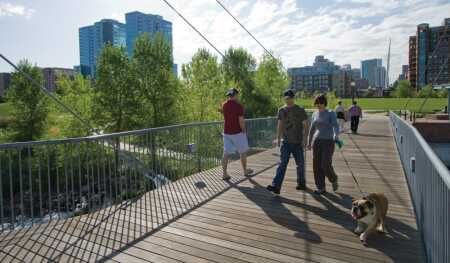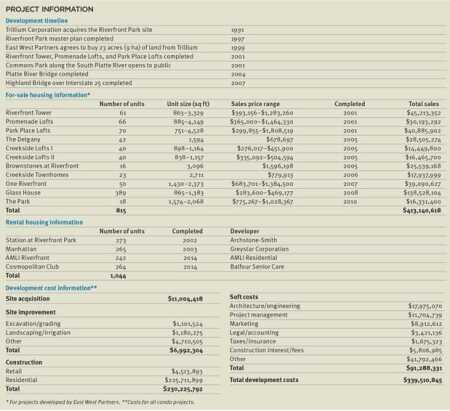In many cities, urban land “on the other side of the tracks” is often undervalued or overlooked. But in Denver, the vision of both public and private sector leaders has transformed such an area into a vibrant new neighborhood that has been instrumental in transforming the heart of the city. Riverfront Park is the result of a 25-year collaboration to create a successful new urban residential community in downtown Denver. Built under a form-based zoning code, which is a means of regulating development to achieve a specific urban form, the development includes 1,859 multifamily condominium and rental units in 14 buildings. The first three buildings were completed in 2001, and two new buildings were delivered in 2014.
Related: ULI Case Study: Riverfront Park | More Case Studies
The development has been designed to fit within and enhance the city’s fabric, and is connected to surrounding areas by four pedestrian bridges that cross railroad tracks, an interstate highway, and the South Platt River. The project is adjacent to the 19-acre (7.7 ha) Commons Park built by the city, and also includes a skate park, a dog park, and a park along Cherry Creek that are within the Riverfront Park property.
Denver was founded at the confluence of two quiet waterways, the South Platte River and Cherry Creek, where gold was first discovered in the region. Riverfront Park is adjacent to this confluence.
Before it was redeveloped, the site was owned for many years by the Burlington Northern Railroad and included a huge rail yard, as well as some old industrial warehouses.
The idea for the project emanated from several sources, including the city of Denver, which had a vision for redeveloping the railroad yards and adding parkland and new development to the area; Trillium Corporation, which bought the land from the railroad and worked with the city to plan and entitle the area for redevelopment; East West Partners, a resort developer that purchased the land in 1999 and became the master developer for the project; and Crescent Real Estate Equities, which partnered with East West on development when East West bought the land and provided critical equity financing.
In 1991, Trillium Corporation acquired several hundred parcels of land in several states from Burlington Northern Railroad, including several excess parcels located in downtown Denver. In April 1999, East West Partners, together with the firm’s longtime equity partner, Crescent Real Estate, purchased 23 acres (9 ha) of entitled land from Trillium and began redeveloping that site into what is now Riverfront Park. One of the main reasons that East West was attracted to the property was the adjacent Commons Park that was being developed by the city.
East West’s vision for the project, while similar to the city’s vision, was framed by the firm’s experience as a resort developer. Two of the firm’s principals, Harry Frampton and Mark Smith, had spent much of their careers developing resort communities and mixed-use villages oriented around mountain and ski amenities in Colorado and other western states. Riverfront Park, they believed, could be thought of in a similar fashion, but with the city and the nearby Commons Park and Platte River as the amenities. Their objective was to create a quiet urban residential neighborhood with easy access to both the urban park and downtown Denver. To a certain degree, they thought of the project as an urban resort.
A public process was undertaken by the city of Denver in the 1990s to prepare and execute a 21-block infrastructure and development plan. The overall plan and design have been shaped by two critical infrastructure elements that were essential to making the project work. One was the aforementioned Commons Park, the first element that was planned and built, developed by the city.
This park includes a pedestrian bridge over the South Platte River, which connects the project with neighborhoods to the north. The park created a highly desirable amenity directly adjacent to the project, greatly enhancing the views from the residences and providing active open space for recreational activities such as biking, walking, and jogging.
The second element was another pedestrian bridge—Millennium Bridge, completed in 2002—that spans the railroad tracks, aligns with the 16th Street pedestrian mall in downtown Denver, and connects the project to the Union Station redevelopment, another major mixed-use development also being developed by East West Partners, with early phases having opened in 2014. The bridge, which cost $11 million to build, was partly funded by the developers, with the rest paid for by the city, which also oversaw the design to ensure that the bridge would be a prominent iconic structure that could attract attention and draw pedestrians to the area.
Riverfront Park is an important new center of activity in Denver, and, from 2001 through 2014, has generated $413 million in condo sales. The development has been especially successful in contributing to the creation of a new pedestrian corridor within Denver that encompasses new pedestrian bridges over rivers, railroads, and highways. The four pedestrian bridges—over the railroad tracks, the Platte River, and Interstate 25—that now connect the downtown with Riverfront Park and neighborhoods to the northwest have been transformative for the city and are heavily used by walkers, bikers, and joggers. This pedestrian pathway has greatly encouraged nonvehicular travel patterns within the Denver core, making the city a greener, healthier, and more attractive place to live and visit.
For more information on Riverfront Park, including videos, photographs, site plans, and financial information, visit ULI Case Studies at www.uli.org/casestudies.
Dean Schwanke is senior vice president, case studies and publications for ULI.






